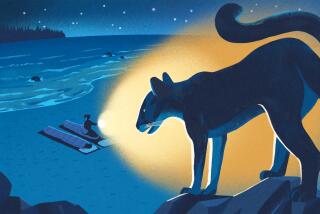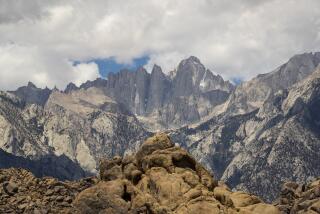Rescue Me
I had almost made it across the face of Kaldalkofsfjoll ice cap in central Iceland when I noticed the weather closing in from the southwest. I was hiking alone across open country on a late summer evening, from the Strutslaug hot springs toward the trekking hut in Landmannalaugar national park. By the time I’d pulled off my crampons and shimmied into my foul-weather gear, I was pinned down in a scouring hailstorm, the pea-sized pellets ricocheting off the glacier and into my face. It was like being swarmed by icy bees. I had nothing to do but take cover under my backpack and wait for the towering, blue-black thunderhead to pass over.
The rain and hail blew for an hour and then, as if a switch had been thrown, disappeared. I pulled my hood back. The deep violet sky silhouetted the distant rhyolite peaks and filled the valleys with a dim, alien light. But I couldn’t appreciate it. It was after 8 p.m., I was tired, wet and freezing cold. I had to get off the glacier.
To make a long story short, I got lost. Unknown to me at the time, Landmannalaugar’s vast, iron-rich volcanic flows play havoc with compasses, and after three desperate hours thrashing around in the boulder-strewn darkness with only my headlamp to see by, I collapsed by a small glacial stream, glowing white in the starlight. And then the cold took hold of me, a racking, vindictive chill I never felt before or since. I managed to get my bivvy tent and sleeping bag out but not before it occurred to me that, quite contrary to my plans for the day, I might freeze to death.
Do you wonder what one thinks at such a time? He thinks, almost exclusively: “My God, I’m cold.”
Did I deserve to be rescued? It depends on whom you ask. One of the most disheartening things about last month’s rescue attempt of three climbers trapped on Mt. Hood, Ore., was the number of people willing to argue that, no, these mountain climbers--having undertaken a risky winter ascent purely for thrills--got what they deserved and taxpayer money shouldn’t be squandered in the elaborate rescue. Among the critics were strange bedfellows Rosie O’Donnell and noted alpine authority Bill O’Reilly. “You don’t go up there in winter,” O’Reilly said. “That’s insane.” Alas, as a story in this paper pointed out, the most serious climbing disasters on Mt. Hood have occurred in spring and summer. O’Reilly gives me a crampon.
After a lengthy search had recovered only one of the men’s bodies, the question of the operation’s cost was put to Hood River County Sheriff Joe Wampler. “I haven’t even thought about it,” Wampler said, to his credit. “Two men are still stuck up on that mountain.”
It’s a curious thing to have people counting pennies at such a time. Is it simply frustration at having to shell out for other people’s foolishness? Actually, most search-and-rescue efforts are manned by volunteers. And besides, these guys were no fools. They had done everything right (with the possible exception of using GPS locator devices). Their plan to attack the mountain--a rapid-ascent strategy--was sound. Their gear was right. I’m no expert, but it’s hard to see how these climbers could have been more responsible.
If presumption of risk is the standard for adjudicating rescues, you could argue the victims of the Sago Mine disaster--not having the good sense to avoid the coal industry--should have been left underground. CNET editor James Kim drove miles down a logging road in Oregon, long past the point when prudence might have dictated turning around. People in New Orleans should have left the city when they had the chance. Baby Jessica should have avoided the well.
Life is high-risk behavior. If we begin to insist that victims be without fault before they are worthy of rescue, we each may one day find ourselves on the wrong side of that equation.
The Mt. Hood blowback could also have something to do with the fact that outdoor adventurists are an increasingly unfathomable breed. The National Park Service is in the midst of an attendance crisis, with backcountry camping down nearly 24% between 1995 and 2005. Perhaps the lack of sympathy for the Mt. Hood victims isn’t a failure of altruism, but of recognition: What could those strange men up on that mountain possibly have in common with me?
Americans are increasingly sedentary, and young people, living in a kind of electronic house arrest between the computer and the game console, are infrequent park visitors. Ironically, high-performance outdoor gear--like The North Face Denali jacket--is one of the hottest fashion trends on campus. America’s wardrobe is a lot like their SUVs, status symbols of excess capacity.
I see all those Patagonia and Arc’teryx jackets in the mall and wonder, what’s with the get-ups? America’s eHarmony posting would no doubt describe itself as “outdoorsy” and adventurous, but it’s mostly wishful vanity.
As for Iceland, I spent a short, hypothermic night under the stars, and when the sun began lightening the sky at around 3 a.m. I could see, no more than 200 yards away, the hut I had been searching for.
Should I have been rescued? I’m just glad it never came to a vote.
More to Read
Sign up for The Wild
We’ll help you find the best places to hike, bike and run, as well as the perfect silent spots for meditation and yoga.
You may occasionally receive promotional content from the Los Angeles Times.






